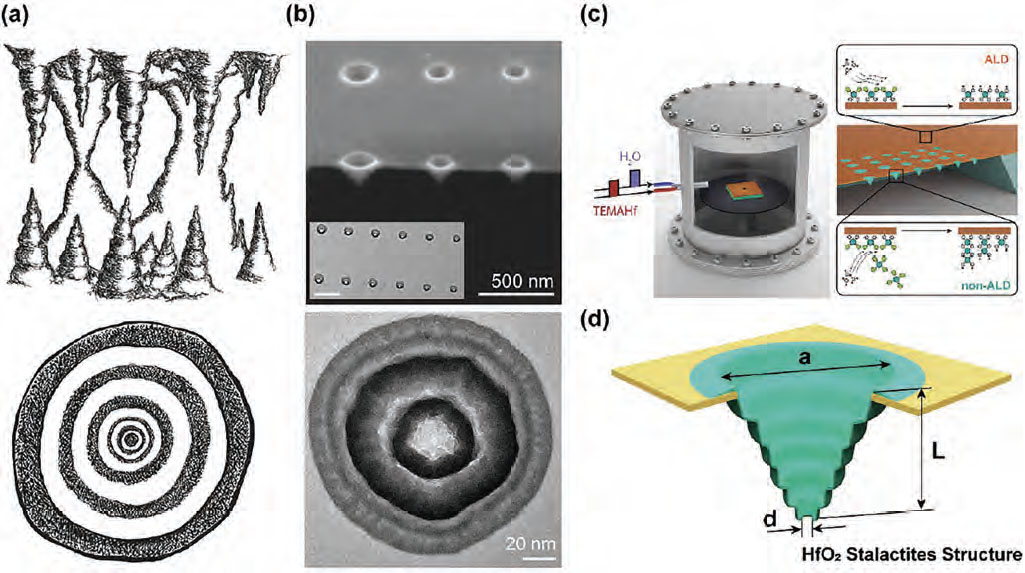| Sep 14, 2023 | |
Scientists design artificial 'stalactite' nanopores that mimic natural structures |
|
| (Nanowerk Spotlight) Nanopores are emerging as a powerful platform technology with applications across biosensing, energy harvesting, and other fields. However, most existing solid-state nanopore designs face challenges like instability, difficulties tuning the size, and inadequate ion selectivity. Scientists have been searching for ways to create more versatile nanopores to overcome these limitations. | |
| Researchers at the Ecole Polytechnique Fédérale de Lausanne (EPFL) in Switzerland have developed a new method to create asymmetric, conical-shaped nanopores that mimic the structure of natural stalactites. These "stalactite" nanopores, described in a paper published in Advanced Materials ("Nature-Inspired Stalactite Nanopores for Biosensing and Energy Harvesting"), could have applications in biosensing, energy harvesting, and filtration technologies. | |
 |
|
| Natural and nature-inspired stalactite nanostructures. a) Stalactites and stalagmites: Artist’s representation of the natural formations created by using periodic thermodynamic conditions and material supply (top). The stalactite cross-section schematic (bottom): rings correspond to the growth cycles. b) Electron microscopy (EM) micrographs of HfO2 stalactite nanopores on the templated silicon nitride apertures obtained in this study: scanning electron microscopy (SEM) side-view image (top), and the high-resolution transmission electron microscopy (TEM) top-view image of a single pore (bottom) that is similar to the stalactite periodic structure. The inset shows the TEM image of several nanopores. Scale bar, 500 nm. c) The growth procedure consists of the regular ALD and the selective templated aperture growth. d) Schematic 3D view of the stalactite nanopore. Arrows show variable dimensions of the nanopore. (Reprinted with permission by Wiley-VCH Verlag) | |
| Nanopores are tiny holes in synthetic membranes, generally ranging from 1 to 100 nanometers in diameter. Due to their small size, they can be used to detect and manipulate molecules and ions at the individual level. However, most existing solid-state nanopore platforms face challenges such as instability, difficulties with size tuning, and lack of ion selectivity. | |
| The researchers took inspiration from naturally occurring stalactites and other tapered structures formed by minerals precipitating out of liquids. They set out to artificially recreate the process of stalactite growth at the nanoscale using state-of-the-art fabrication techniques. | |
| The team started with a template made of silicon nitride containing an array of tiny apertures. They then used a process called atomic layer deposition to deposit hafnium oxide onto the template in a cyclical manner, forming ring-shaped layers inside the apertures. | |
| This resulted in asymmetric, cone-shaped stalactite nanostructures protruding from the holes in the silicon nitride template. The dimensions of the stalactite nanopores could be precisely controlled by tuning the template aperture size and the number of deposition cycles. | |
| Importantly, the researchers demonstrated two key advantages of these biomimetic stalactite nanopores compared to existing cylindrical solid-state pores. First, the asymmetric shape creates a non-uniform electric field within the pore, enabling direction-selective capture and translocation of charged biomolecules like DNA. Second, the conical geometry provides enhanced ion selectivity and rectification when used for harvesting energy from salinity gradients. | |
| To test the biosensing capabilities, the team performed DNA translocation experiments, observing significantly higher passage rates when the DNA travels from the tip to the base compared to the reverse direction. This effect results from the DNA needing to overcome a higher energy barrier when moving into the wide opening versus exiting through the narrow tip. | |
| For energy harvesting, the researchers showed that the stalactite nanopores generate higher electric currents and power densities from salt concentration gradients when the salt solution flows from tip to base. This direction selectivity arises from differences in the electric double layer inside the asymmetric pore. | |
| Having demonstrated the advantages on single pores, the researchers then scaled up the process to fabricate stalactite nanopore arrays covering 400 micrometers squared. This nanopore array generated a power density of 20 W/m2, representing an important step toward practical applications like blue energy harvesting. | |
| Overall, this work introduces a versatile platform technology for crafting asymmetric biomimetic nanostructures. With optimization of size and surface properties, stalactite nanopore arrays could enable real-world breakthroughs in areas like rapid DNA sequencing, lab-on-a-chip devices, desalination, and microscale power generation. The researchers highlight that stalactite nanopores made from hafnium oxide are also remarkably stable. | |
| By mimicking nature’s approach, the EPFL scientists have opened up new possibilities for designing nanoscale architectures with enhanced functionalities. Their bioinspired approach demonstrates how naturally occurring structures can provide blueprints for engineering novel nanomaterials. | |
 By
Michael
Berger
– Michael is author of three books by the Royal Society of Chemistry:
Nano-Society: Pushing the Boundaries of Technology,
Nanotechnology: The Future is Tiny, and
Nanoengineering: The Skills and Tools Making Technology Invisible
Copyright ©
Nanowerk LLC
By
Michael
Berger
– Michael is author of three books by the Royal Society of Chemistry:
Nano-Society: Pushing the Boundaries of Technology,
Nanotechnology: The Future is Tiny, and
Nanoengineering: The Skills and Tools Making Technology Invisible
Copyright ©
Nanowerk LLC
|
|
|
Become a Spotlight guest author! Join our large and growing group of guest contributors. Have you just published a scientific paper or have other exciting developments to share with the nanotechnology community? Here is how to publish on nanowerk.com. |
|
